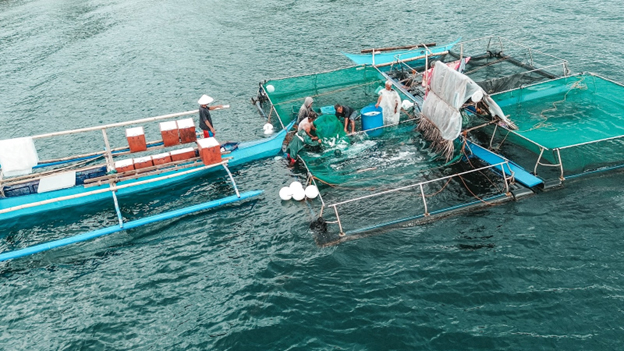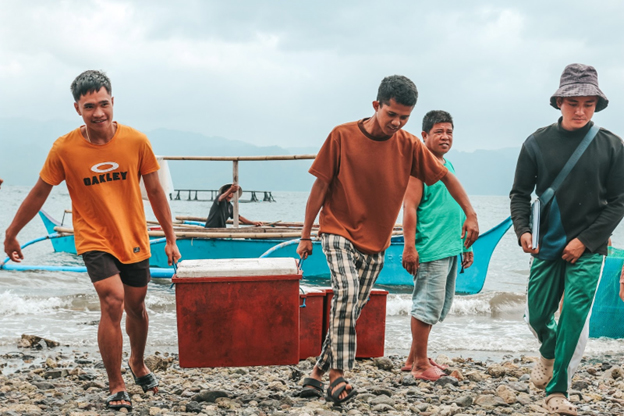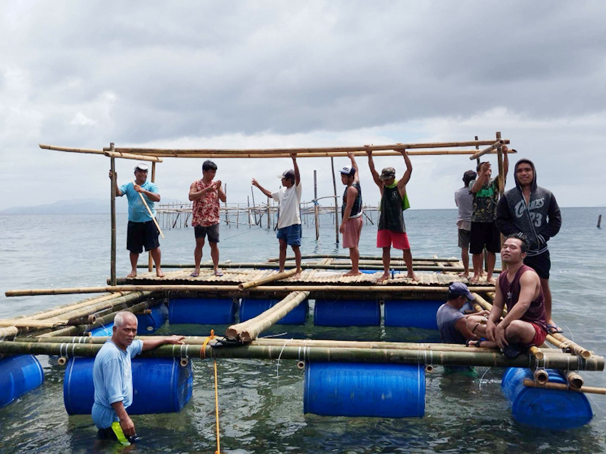Officers and members of an organization of fisherfolk in the municipality of Tomas Oppus, Southern Leyte, are bracing themselves up for the second cropping of their bangus fish cage project following the success of the enterprising venture in January this year.
“Karong buwan sa Marso second cropping na. Libre gihapon mi og feeds, mga fingerlings nga lima ka libo ka buok. Ang halin namo sa unang cropping gipalit namo og laing cage par ma-expand pa,” said Rael Beronilla, vice president of Canlupao Association of Fisherfolks (CAFA).
(This March, we're starting the second round of cropping. Feeds and five thousand fingerlings are still provided at no cost. The money we earned from the first round was used to purchase another cage for expansion.)

Getting ready to harvest bangus fish in a cage for the first cropping on January 26, 2024. (Photo courtesy of BFAR SAAD OTSO)
Beronilla shared that personnel from the Bureau of Fisheries and Aquatic Resources (BFAR) provincial office conducted a survey last year in the municipality of Tomas Oppus looking for the bangus fish cage project recipients.
CAFA was chosen from three or four associations surveyed mainly because it already had a project with the Department of Agriculture (DA), Beronilla informed the Philippine Information Agency during a phone call. CAFA received the bangus culture in cage livelihood package, a set of fishing inputs totaling P1,015,630. The amount covered cost of 5,000 bangus fingerlings, 202 bags of feed, one stainless steel cage, and 10 units of fish tubs.

The fisherfolk in Barangay Canlupao, Tomas Oppus, enjoyed a bountiful harvest of bangus in a fish cage project granted by the Bureau of Fisheries and Aquatic Resources (BFAR) under the Special Area for Agriculture Development (SAAD). (Photo courtesy of BFAR SAAD OTSO)
Management of the project under CAFA began in earnest in September 2023, and five months later, on January 26, the first harvest of almost 2,000 kilos of bangus raised in a cage in the seawaters of Sogod Bay was successfully carried out.
“Gibaligya namo tag P170 ang kilo sa wholesale, ug sa mga tingi-tingi, tag P200 kada kilo. Nagkuwang pa, daghan pang gusto mopalit,” Beronilla said, indicating a sure, sustainable market for their hard work and effort.
(We sold it at P170 per kilogram wholesale, and for retail, it's P200 per kilogram. Still, there are many who want to buy.)

Fresh bangus in tubs ready for delivery to wholesale and retail buyers. (Photo courtesy of BFAR SAAD OTSO)
Inspiration, challenges
Encouraged by the successful initial harvest, Beronilla and his fellow farmers are enthusiastic about starting again. However, the waters of Sogod Bay must be observed carefully in accordance with the changing season.
The strong under-the-sea current in the first few months of the year was one of the factors that delayed the second cropping. Hands-on watch in the next cycle, day and night, will also be a challenge, in addition to the hot summer months.
Despite this, their enthusiasm is further fueled by the knowledge that they will have two cages this time, with the second one purchased using their earnings. This alone is something they eagerly anticipate. BFAR will provide material and technical support for two years or more based on the group's performance.
“We will continue to monitor CAFA and the other 2023-2024 batch of people’s organization beneficiaries,” said Lalaine Biong, SAAD coordinator at the BFAR provincial office.
Biong, Redyl Dadulo, provincial SAAD focal person, and Aprilyn Bruzas, the area coordinator, facilitated the bangus culture in a cage project undertaken by CAFA.
“We chose CAFA based on their good financial record, which is in order, and they are not a beneficiary of DA/BFAR-SAAD Phase 1 projects,” Biong shared in a chat message.

Members and officers of the Canlupao Association of Fisherfolks (CAFA) posed for a photograph with their new cage made of bamboo and drums, which was purchased out of the income during the first cropping. This cage, in addition to the one already in use, will be used for the second cropping. (Photo courtesy of Lalaine Biong, BFAR provincial office information officer)
Purpose served
As shown during the bountiful first harvest in January, it was the right choice. Although the yield for the second cropping still needs to be seen to determine whether it can surpass the month’s record, the fact remains that the project has accomplished its goal and purpose.
The government's intervention, in the form of a sustainable livelihood opportunity, has contributed to poverty reduction. It has had a tangible impact on the living conditions of vulnerable fisherfolk families, empowering them through a fishery-driven business enterprise.
Along the way, food security was enhanced, and economic growth was promoted in targeted areas around the country, in this case, Southern Leyte province. (MMP, PIA Southern Leyte)

